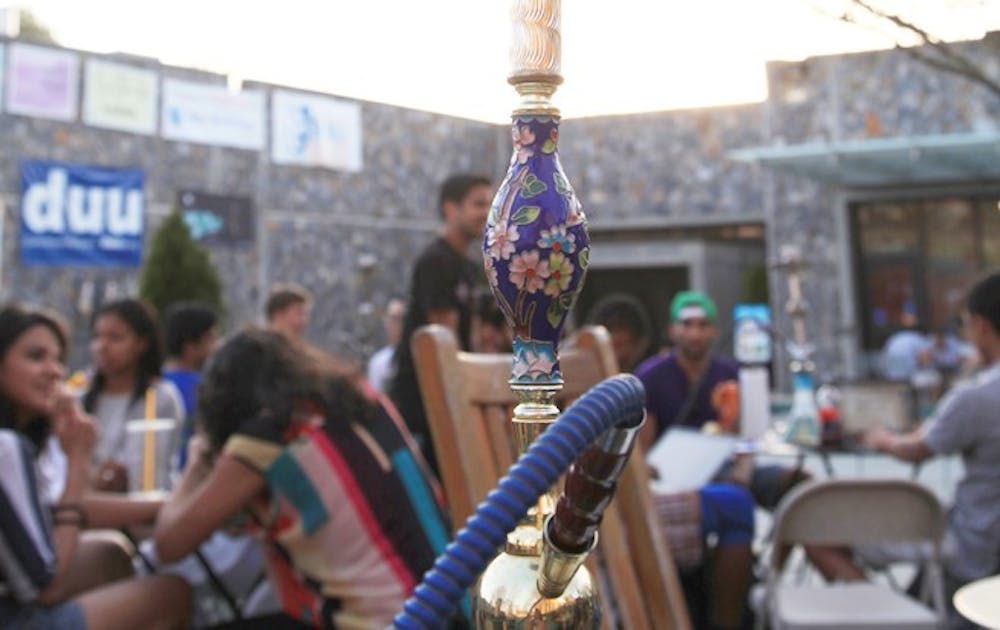Despite the presence of three hookah lounges on or near campus, many cite Duke as still having an “underground” hookah culture.
Originating in India, hookah refers to the mechanism used to smoke flavored tobacco through a water basin. The practice is relatively common among college students, with between 15 and 48 percent having engaged in the practice and between 9.5 and 20 percent having smoked hookah in that past 30 days, according to a 2011 research study conducted by Isaac Lipkus—professor at the School of Nursing and the department of community medicine and director of the Risk Communication Laboratory. Despite hookah’s relatively strong presence among college campuses nationwide, usage among Duke students appears to have been limited to certain social niches.
“I don’t think smoking hookah is as prevalent on Duke’s campus as I’d like to imagine,” junior Sam Roh said. “It’s an activity that’s being more widely accepted in Western culture, but I think the hookah culture is still underrepresented.”
Underground activity
Sophomore Nikhil Viswanathan noted that Duke’s hookah culture is still “pretty underground.”
“[It’s] definitely not a popular thing given the lack of locations to do it, a stigma towards any and all tobacco and lack of time,” he said.
Employees from Afghani restaurant Bread and Kebab, located at 1013 West Main Street, said they have observed that the number of college students using hookah at the restaurant has remained relatively steady in recent years.
Although college students make up a considerable percentage of the customer base who smoke hookah at 1013 Bread and Kabob, the majority is comprised of a slightly older crowd, said Veke Loynab, an employee at the restaurant.
“For every 15 college kids that come in [to smoke hookah], there are about 25 customers who are over the age of 24,” he added.
On the other hand, Sam Mouabid, owner of the Trinity Lounge on West Markham Avenue, said with its location immediately off East Campus, the majority of the clients who search for hookah are Duke students. Since the bar began to supply hookah approximately eight months ago, the student ratio has “tremendously” increased, he added.
Sophomore Rob Bruce noted that he frequented the Duke Coffeehouse, located on East Campus, during his freshmen year to smoke hookah, a product the student-run establishment sells on food points. Bruce has since purchased his own hookah, yet noted that he does not smoke it as often as he would at the Coffeehouse.
Not safer than cigarettes
Some may be drawn to hookah because it is perceived as less addictive and safer than cigarette smoke, but hookah contains the same toxins as cigarette, said Devon Noonan, assistant professor at the School of Nursing.
“Most people aren’t even aware that [waterpipes] are connected to tobacco,” she said. “The toxins associated with tobacco, such as tar, are also present in the hookah smoke and pose the same dangers.”
People also tend to believe that drawing the smoke through the water filters it, when in reality the water merely cools the smoke, Viswanathan said. Such cooling allows the lungs to accept the smoke more easily.
“Students may think it’s safer because... [the hookah smoke] doesn’t feel or smell as harsh, but really it’s just unfiltered tobacco and molasses,” Bruce added.
As someone who does not smoke cigarettes, Roh noted that he does not find hookah smoking as an alternative to cigarette tobacco.
“I’m sure people who smoke cigarettes regularly are more inclined to smoke hookah, but it doesn’t work the other way around,” he said. “Smoking hookah doesn’t make it any more likely that you will smoke cigarettes.”
Although higher levels of toxic compounds are found in cigarettes, there is a trade-off because hookah smoking allows for bigger hits for longer periods of time, which could cause hookah smokers to actually absorb higher concentrations of these toxins, Roh added.
Although most recreational hookah users tend to smoke less frequently than cigarette smokers, the threat of nicotine addiction nevertheless remains, Noonan added.
Get The Chronicle straight to your inbox
Sign up for our weekly newsletter. Cancel at any time.
“We still don’t know the real dangers associated with smoking hookah—and given its increasing popularity, it’s important to find out,” Noonan added.
Social outlet
Despite these health concerns, for Roh and other students, hookah smoking has become a social outlet. In dormitories or at local lounges, hookah has been a source of relaxation in social gatherings.
“I’ve rarely come across people who smoke hookah alone,” Roh said, adding that he and his friends smoke hookah almost daily, especially during the weekends.
The buzz or mild euphoric sensation associated with the waterpipe, Roh said, helps him and his friends wind down after a long night of studying.
Bruce also said the activity is social in nature, noting that he has a group of friends with whom he usually smokes and studies.
“It’s the same way as grabbing coffee or getting something to eat, but it’s usually more relaxing and stress relieving,” he added.

